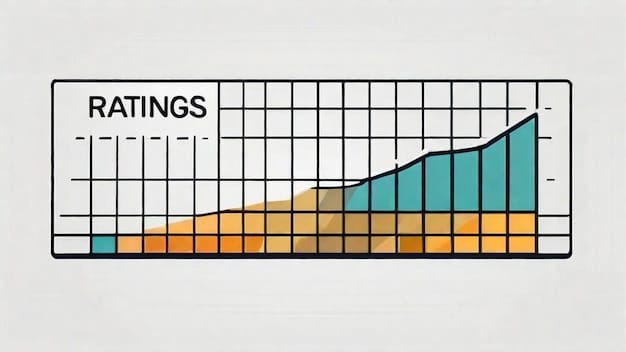Investing in Small-Cap Stocks: Can They Beat Large-Caps by 5%?

Investing in small-cap stocks presents an opportunity to potentially outperform large-cap stocks by 5% within a year, driven by their higher growth potential, but it also involves higher risks that require careful evaluation and strategic investment.
Investing in small-cap stocks: can these companies outperform large-caps by 5% in the next year? This is a question many investors ponder, searching for opportunities to maximize returns in a dynamic market. Let’s delve into the potential and pitfalls of investing in these smaller companies.
Understanding Small-Cap Stocks
Small-cap stocks represent companies with smaller market capitalization compared to large-cap stocks. These companies often possess high-growth potential but also come with increased volatility and risk. Let’s clarify what defines them and how they differ from their larger counterparts.
What Defines a Small-Cap Stock?
Typically, small-cap stocks are defined as companies with a market capitalization ranging from $300 million to $2 billion. This can vary slightly depending on the source, but this range is generally accepted. These companies are often in earlier stages of growth compared to larger, more established corporations.
Key Differences Between Small-Cap and Large-Cap Stocks
The main differences lie in growth potential, risk, and stability. Large-cap stocks, with market caps over $10 billion, are generally more stable but offer lower growth potential. Small-cap stocks can offer higher growth rates but come with increased risk due to their smaller size and susceptibility to market fluctuations.
- Growth Potential: Small-caps often have more room to grow.
- Risk: Higher volatility and risk of failure.
- Stability: Large-caps offer more stability and consistent returns.
- Market Influence: Large-caps have more influence on market indices.
Understanding these distinctions is crucial for any investor looking to diversify their portfolio. Small-cap stocks can be a valuable addition for those seeking high-growth potential, but it’s essential to be aware of the accompanying risks.
Historical Performance of Small-Cap Stocks
Examining the historical performance of small-cap stocks can provide insights into their potential to outperform large-cap stocks. Long-term data reveals cycles of outperformance and underperformance, influenced by various economic factors. Let’s look at the numbers.
Historically, small-cap stocks have shown periods of significant outperformance compared to large-cap stocks. For example, during certain economic expansions, small-cap stocks have benefited from increased investor risk appetite and growth expectations. However, this outperformance is not consistent.
Analyzing Past Trends
Past trends indicate that small-cap stocks tend to do well in the early stages of economic recovery, as they are more sensitive to economic growth. During economic downturns, however, they can underperform due to their higher risk profile.
- Economic Expansions: Often outperform due to high-growth potential.
- Economic Contractions: Can underperform due to higher risk.
- Interest Rate Sensitivity: More sensitive to changes in interest rates.
- Market Sentiment: Influenced significantly by investor sentiment.
It’s important to remember that past performance is not indicative of future results. Economic conditions, market sentiment, and sector-specific factors all play a role in determining the performance of small-cap stocks.
Historical data provides a valuable context for understanding the potential and limitations of small-cap investments. By analyzing these trends, investors can make more informed decisions, balancing the opportunities for high returns with the inherent risks.
Factors Driving Small-Cap Outperformance
Several factors can contribute to the outperformance of small-cap stocks. These drivers often relate to market conditions, economic cycles, and company-specific characteristics. Let’s examine the key elements.
One of the primary drivers of small-cap outperformance is their high-growth potential. These companies are often in emerging industries or have innovative business models that allow them to grow at a faster rate than larger, more established firms. The greater flexibility and agility of smaller companies enable them to adapt more quickly to changing market conditions.

Economic Conditions
Favorable economic conditions, such as low interest rates and increasing consumer spending, can significantly boost small-cap stocks. These conditions support growth and encourage investor confidence in riskier assets.
Company-Specific Catalysts
Unique catalysts, such as new product launches, strategic acquisitions, or successful market expansions, can drive significant gains in individual small-cap stocks. Identifying these opportunities requires deep research and a thorough understanding of the company’s business model.
- Innovation: Small-caps often lead in disruptive technologies.
- Acquisition Potential: Attractive targets for larger companies.
- Market Niches: Specialization in underserved markets.
- Management: Entrepreneurial leadership driving growth.
Various, intertwined factors propel small-cap outperformance. Investors need to monitor both macroeconomic trends and company-specific developments to capitalize on these opportunities. Such a holistic approach can enhance the chances of identifying and benefiting from high-growth small-cap stocks.
Risks Associated with Small-Cap Investing
Investing in small-cap stocks comes with inherent risks that investors need to acknowledge. Understanding these risks is essential for making informed decisions and managing potential losses. Let’s explore these caveats.
One of the most significant risks is higher volatility. Small-cap stocks tend to experience larger price swings compared to large-cap stocks, making them more susceptible to market fluctuations and economic uncertainties. This volatility can lead to substantial gains, but also significant losses.
Liquidity and Market Sentiment
Liquidity can be a concern with small-cap stocks, as they often have lower trading volumes. This can make it difficult to buy or sell shares quickly without affecting the price. Additionally, market sentiment can heavily influence small-cap stocks, leading to rapid changes in valuations.
Economic downturns and negative news can disproportionately impact small-cap stocks. Their smaller size and limited resources make them more vulnerable to financial distress compared to larger, more established companies.
- Volatility: Greater price swings can lead to losses.
- Liquidity: Lower trading volumes can pose challenges.
- Financial Stability: More vulnerable to economic downturns.
- Information Asymmetry: Less information available compared to large-caps.
Understanding and managing these risks is paramount in small-cap investing. Investors should conduct thorough due diligence, diversify their portfolios, be prepared for periods of underperformance to mitigate these risks, and adopt a long-term investment horizon.
Careful risk assessment and management are crucial for successfully navigating the small-cap market. By acknowledging and preparing for these risks, investors can improve their chances of achieving their investment goals.
Strategies for Identifying Promising Small-Cap Stocks
Identifying promising small-cap stocks requires a combination of research, analysis, and a strategic approach. Investors can employ various strategies to uncover the hidden gems within this asset class. Let’s examine these approaches.
One effective strategy is to focus on companies with strong growth potential. Look for businesses that are innovating in their respective industries or targeting underserved markets. These companies often have the potential to generate significant returns as they scale their operations.
Fundamental and Quantitative Analysis
Conducting thorough fundamental analysis is essential. This involves examining a company’s financial statements, assessing its competitive position, and evaluating its management team. Quantitative analysis can also provide valuable insights by analyzing key financial ratios and metrics.

Industry and Sector Focus
Focusing on specific industries or sectors can help investors identify emerging trends and promising small-cap companies. For example, companies in the technology, healthcare, and renewable energy sectors often offer high-growth opportunities.
- Industry Trends: Identify sectors with high-growth potential.
- Financial Health: Focus on companies with strong balance sheets.
- Management Quality: Assess the experience and vision of leadership.
- Competitive Advantage: Look for unique strengths and differentiation.
By combining these strategies, investors can increase their chances of finding promising small-cap stocks. The key is to conduct thorough research, maintain a disciplined approach, and remain patient throughout the investment process.
Employing these strategies can lead to a more informed and successful small-cap investment experience. With diligence and patience, investors can uncover opportunities for substantial returns and long-term growth.
Can Small-Caps Outperform by 5% in the Next Year?
Assessing whether small-cap stocks can outperform large-cap stocks by 5% in the next year requires analyzing current market conditions and future projections. Several factors could influence this outcome. Let’s analyze relevant forecasts.
The likelihood of small-caps outperforming large-caps by 5% in the next year depends on several variables, including economic growth, interest rates, and investor sentiment. Favorable economic conditions and positive market sentiment can create an environment conducive to small-cap outperformance. The flexibility and agility of smaller companies are crucial in adapting to rapidly shifting economic events.
Economic Forecasts and Market Sentiment
Current economic forecasts suggest moderate growth, which could benefit small-cap stocks. However, uncertainty remains due to ongoing geopolitical tensions and potential changes in monetary policy. Investor sentiment plays a crucial role, as increased risk appetite can drive more capital into small-cap stocks.
Historical Trends and Future Projections
While historical trends show periods of small-cap outperformance, future projections must consider current market dynamics. Factors such as inflation, supply chain disruptions, and technological advancements could impact the relative performance of small-cap and large-cap stocks. Sector-specific analysis can offer valuable insights into where potential outperformance might occur.
- Economic Growth: Moderate growth favors small-caps.
- Interest Rates: Low rates boost growth stocks.
- Investor Sentiment: Positive sentiment drives investment.
- Sector-Specific Factors: Opportunities in tech, healthcare, etc.
Therefore, while it’s possible for small-cap stocks to outperform large-cap stocks by 5% in the next year, it is not guaranteed. Investors should carefully weigh the potential risks and rewards, diversify their portfolios, and stay informed about market developments to make well-informed investment decisions.
Careful monitoring of market conditions and a strategic approach are essential for those seeking to capitalize on the potential outperformance of small-cap stocks. Sound investment strategies will maximize your success while mitigating risks.
| Key Point | Brief Description |
|---|---|
| 🚀 Growth Potential | Small-caps have higher growth potential than large-caps. |
| ⚠️ Risk Factors | Higher volatility and liquidity risks require careful management. |
| 📈 Economic Impact | Economic conditions significantly influence small-cap performance. |
| 🔍 Stock Selection | Due diligence and strategic stock selection are critical for success. |
FAQ
▼
Small-cap stocks are shares of companies with a market capitalization typically ranging from $300 million to $2 billion. They represent smaller, often younger companies with potential for high growth.
▼
The primary risks include higher volatility, lower liquidity, and greater susceptibility to economic downturns compared to large-cap stocks. Thorough research is essential to mitigate these risks.
▼
Look for companies with strong growth potential, innovative business models, and solid financial health, by conducting thorough research and analysis of financial statements.
▼
No, small-cap stocks do not always outperform large-cap stocks. Their performance varies depending on economic conditions, market sentiment, and other macroeconomic factors.
▼
Investors should diversify portfolios, conduct due diligence, and adopt a long-term investment horizon. Being prepared for occasional underperformance is also a vital practice.
Conclusion
Investing in small-cap stocks offers tempting prospects for outperforming large-caps, although it requires careful deliberation with an awareness of inherent risks. By comprehending the dynamics of small-cap stocks, employing thorough analysis, and maintaining a strategic approach, investors can better maneuver the market, enhancing the possibility of achieving favorable outcomes for their investment objectives.





